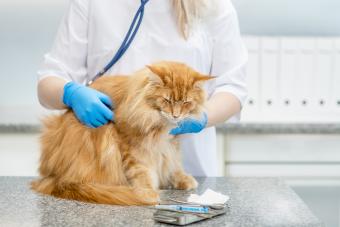
Your cat's tail is an extension of their spine, so any cat tail injury is a serious matter. From skin wounds and hot spots to dislocated or broken tails, there are five common injuries that can happen. If you suspect your cat has a tail injury, you need to treat it right away.
1. Hot Spots
When a cat chews or licks at an itchy spot on their tail (usually triggered by fleas or other parasites), it can create an area of inflammation. This generally happens at the base of the cat, and these moist areas on the skin are known as hot spots.

Signs of Hot Spots
- Broken skin
- Open sore
- Warm area with redness or pinkness
- Oozing or crusting
- Hair loss
- Intense itching
Treatment of Hot Spots on Your Cat's Tail
The area around the hot spot will need to be shaved to allow the wound to breathe and your vet to assess the extent of the damage. Many cats become agitated during shaving, so unless you have experience shaving a cat, you should leave the shaving to your veterinarian. Your vet will also clean the wound with ointment, and they may prescribe antibiotics if a secondary infection is present.
2. Bite Wounds
Cats are scrappy animals, but if they happen to get into a tussle with a wild animal, dog, or another cat, the easiest part of the body for their opponents to grab onto is the tail. Bites can result in infection, so prompt and proper care for the wound is essential.
Signs of a Wounded Tail
- Visible scratch or laceration
- Abscess
- Bleeding
- Bite marks
- Skin or fur missing
- Discoloration (may be due to infection)
Treatment for Bite Wounds on Cat Tails
If the tail is bleeding, getting the bleeding to stop is the first thing you need to do. PetCareRX states you can attempt to stop the bleeding on small wounds by applying pressure to the area with a sterile piece of gauze or clean towel. Once the bleeding stops, use antibacterial soap on the area and cover it with a clean bandage.
Scratches and bites can both lead to serious infection, so after you apply the bandage, bring your cat to the veterinarian so they can determine if antibiotics, stitches, or any other care is needed. If your cat's injury seems dire, do not wait to clean up the cut yourself; bring your cat to the vet immediately.
Outdoor cats have a much higher chance of experiencing tail injuries due to wild animals, cars, and exposure to the elements, so it's always best to keep your cat indoors unless you are supervising them outside.
3. Burns
Because cats are so curious, it's possible your cat could sustain a burn on their tail if they get too close to a candle, fire, or a hot stove. Depending on the depth of the burn, it could only affect the outermost layer of the skin (first-degree burn) or go through to deeper layers (second- or third-degree).
Signs of Burns on Your Cat's Tail
- Singed fur on tail
- Burning smell
- Red skin
- Blisters
- Oozing wound
- Thick, discolored crust
Treatment of a Burned Cat Tail
The first thing you should do for a burn is apply cool water to your cat's skin. You can do this by running water over the area on the tail or applying a cloth to the skin. If the skin is blistered or black, see your veterinarian right away. Even minor burns can be incredibly painful, so pain medications prescribed by your vet can make your cat comfortable. Severe burns will need IV fluids and hospitalization.
4. Broken, Fractured, or Dislocated Cat Tail
Contrary to old wives' tales, cats do not always land on their feet. In fact, PetCareRX reports the majority of breaks and fractures in the tail occur from falls. Breaks, fractures, and dislocations can also result from a tail being run over by a car, being stepped on, or by being accidentally caught in a shutting door. Even children can dislocate a cat's tail if they yank on it.

Signs of Break, Fracture, or Dislocation of Your Cat's Tail
- Kink or bump in the tail
- Swelling in tail
- Slightly drooping tail
- Pain or sensitivity
- No movement in tail
Any of these symptoms may signal a break, fracture, or dislocation. If the tail is dislocated at the base, your cat may also have some issues attempting to use the litter box.
There is no natural reason - barring serious injury or infection - for your cat's tail to fall off. Some breeds are born with shortened tails or no tails at all, and these cats can live normal lives without their tails.
Treatment of a Broken Cat Tail
A broken tail may heal without a splint by applying ice and administering pain medication prescribed by your veterinarian for discomfort. However, some cases require surgery. If you see any signs of a break, you should bring your cat to the vet as soon as possible so they can assess for nerve damage.
A veterinarian may be able to tell if there is a break or dislocation just by looking at the tail, but they will likely want to x-ray your cat's tail. If there appears to be nerve damage, further treatment may be necessary.
5. Nerve Damage of the Tail
Injuries that involve pulling can damage the nerves of a cat's tail. Sometimes, when a cat seeks shelter from the cold weather under the hood of a car, his tail can get mangled in the engine.
Other common accidents include being stepped on, getting the tail caught in a fence or door, and unfortunately, sometimes people inflict harm and deliberately injure a cat's tail. These injuries, known as avulsion injuries or degloving injuries, not only affect the nerves of the tail but also the nerves that cats use to urinate and defecate.
Signs of Tail Nerve Damage
- Visible break
- Limp tail
- Swelling at base of tail
- Difficulty walking
- Pain or sensitivity
- Involuntary urination or defecation
Treatment of Tail Nerve Damage
Your vet may want to do a series of tests, including an X-ray, complete blood count and urinalysis. Depending on the damage, the nerves may heal eventually, but if the damage is severe, or the tail becomes paralyzed, your vet may recommend amputation. If your cat experiences nerve damage with a tail injury, you may have to assist them with eliminating on a daily basis until the injury has healed.
If it looks like your cat's tail is falling off or it's completely detached from their body, there's a high chance of nerve damage. Nerve damage is a serious ailment in cats, and immediate veterinary care is crucial.
Assessing Your Cat's Tail Injury
Tail injuries in cats are common, and larger complications may result if the injury is not treated promptly. If something seems off about your cat's tail, take a closer look. You can save your cat a lot of stress or pain and maybe even their tail by being diligent.







